A 15-Minute Slow Flow Yoga Practice
This article originally appeared on Yoga Journal
One of the things that keeps me coming back to my mat, even when I can only manage a 15-minute yoga practice, is that it helps me stay grounded at times when the world feels chaotic, when people act in unkind or downright intentionally malicious ways, and when more things are coming at me than I think I can handle.
Swami Vivekananda, who was partly responsible for introducing yoga and its philosophy to the West, asserted that the purpose of yoga is to alleviate pain and suffering in the moment and to minimize it in the future. My yoga practice gifts me the nervous system resilience I need so that I can experience exactly what Vivekananda described.
Having a personal yoga practice allows me to come to this sense of physical, emotional, and energetic steadiness and ease on my own. There is no need to turn to anyone or anything else to find a sense of calm or peace or even purpose. Instead, I am able to pull back the layers of culture’s influences, including its messages of not being enough and constant desiring of more, and I reveal what we all are, which is pure light.
The practice of yoga helps us reveal that to ourselves so that we may acknowledge the truth of who we are, which is expansive, calm, and joy-filled. Our nature is perfect.
When I tend to forget that about myself, I practice what I call "slow and low" movement. It’s a slow flow that’s exploratory, grounding, and embodied, and it allows me to shift my state in about the same time as it takes to make a cup of tea.
A 15-minute yoga practice that’s slow and low to the ground
In this sequence of poses, you'll use two blocks to offer yourself even more support. Move, explore, and notice the shift from stressed to grounded.
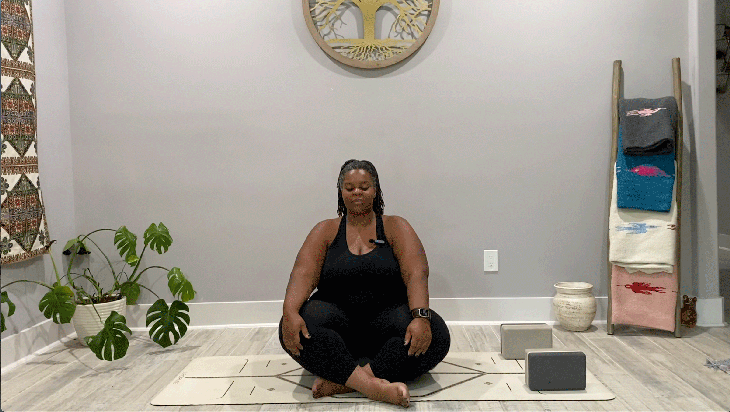
Sukhasana (Easy Seat) with Breath Awareness
Place 2 blocks near the top of the mat and come into a comfortable cross-legged seated position. Sense the floor underneath you. Notice the cadence of your breath. After a few rounds of natural breathing, inhale for as long as feels good, then add a pause at the top of your inhalation. Exhale for as long as feels good, and add a pause at the bottom of your exhalation. Repeat as many times as you need to feel connected and present.
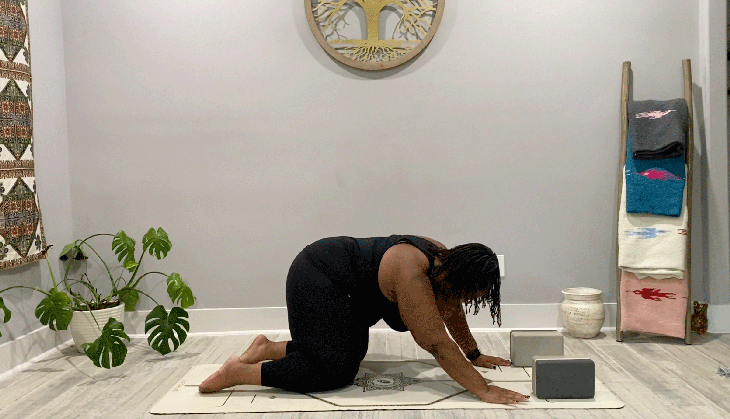
Hip Circles
Come to all fours and begin to make large hip circles, moving your body toward the left side of your mat, then toward the back of the mat, followed by the right side, and then back to center with your shoulders over your wrists.
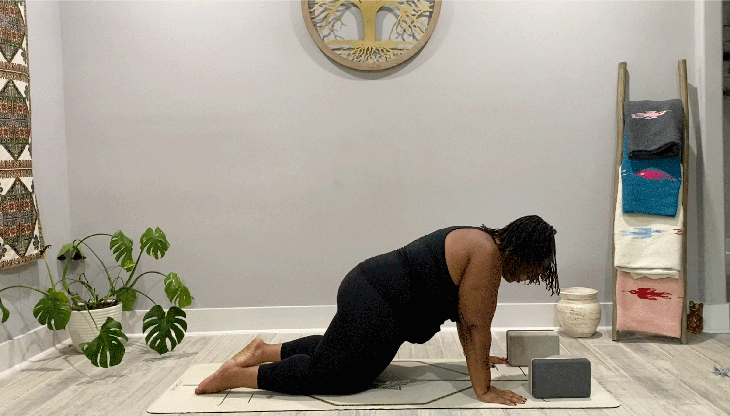
Do this 3 times, noticing how you pass through Child's Pose as you press back, come into side bending when your hips are to the left and right, and wrist strengthening as you come forward.
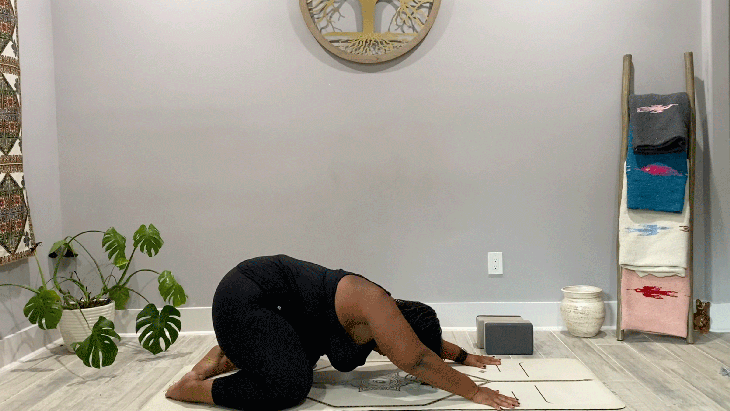
Balasana (Child's Pose)
From all fours, sink your hips back toward your heels with your arms alongside your ears in an active Child's Pose. Press your hands firmly into the mat to create extension and awareness along the upper body. Take a moment in this exploration of how your body feels today.
Release Child's Pose and return to hip circles, swaying your body toward the opposite direction as you started last time. Do this 3 times.
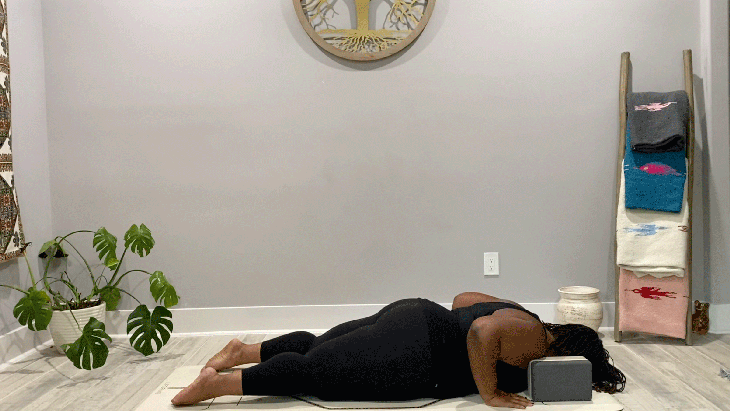
Bhujangasana (Low Cobra With Blocks)
From hands and knees, bring your upper body forward toward the floor and come to lying on the mat, letting the blocks rest under your shoulders.
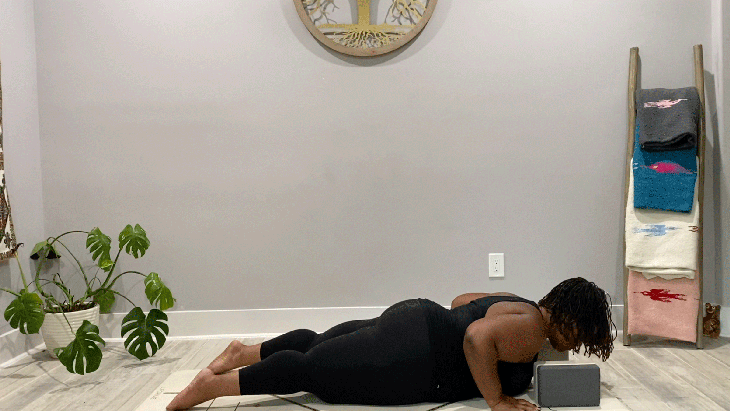
Inhale and engage everything from your toes to your torso as you lift your head and chest away from the mat in Low Cobra and then exhale as you release yourself to the mat. Do this again 3 times. Explore lifting a little higher each time.
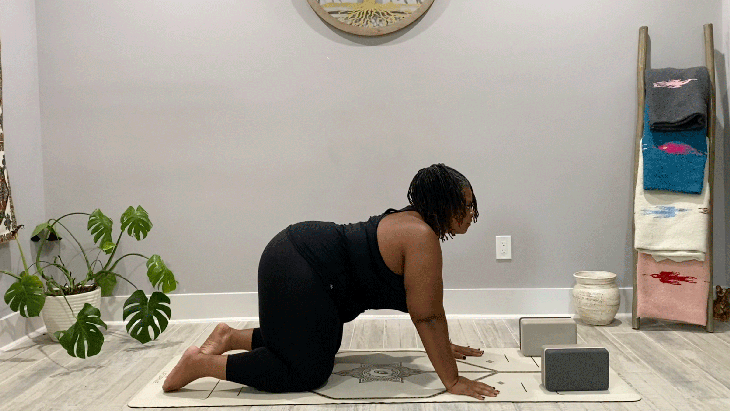
Marjaryasana and Bitilasana (Cat and Cow)
After the dynamic cobra exploration, come back to all fours. Sense the earth underneath your hands, knees, and feet as you inhale and lift your head and seat towards the sky for Cow Pose.
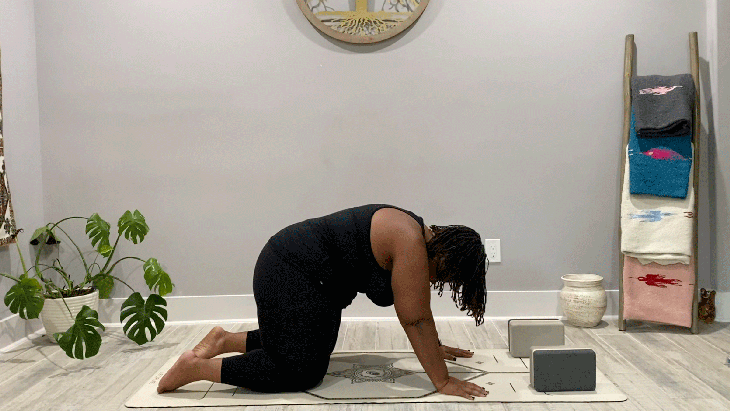
Then exhale and round your spine toward the sky and lower your head and seat in Cat Pose. Repeat this 3 times.
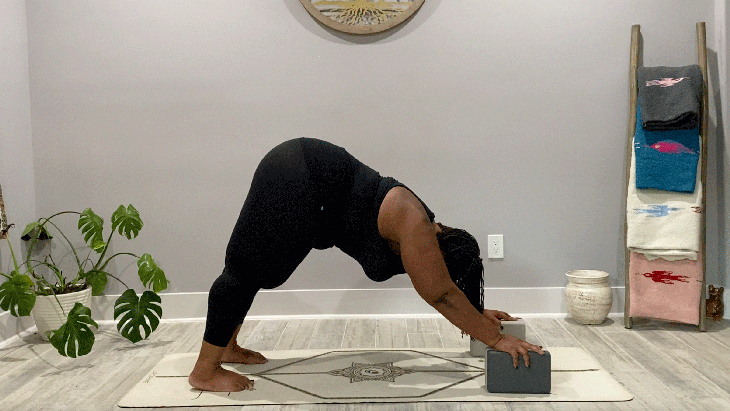
Adho Mukha Svanasana (Downward-Facing Dog Pose With Blocks)
From hands and knees, bring the blocks underneath your hands, tuck your toes, and come into Downward-Facing Dog. Bringing the props under your hands shifts your center of gravity back, therefore reducing pressure on your wrists and hands. Alternate bending right and left knees to welcome in any release and side bending around your low back, which is more noticeable with your hands a bit higher.
Half Sun Salutations
From Down Dog, grab the blocks underneath your hands and walk them back to your feet and fold forward in Uttanasana (Standing Forward Bend).
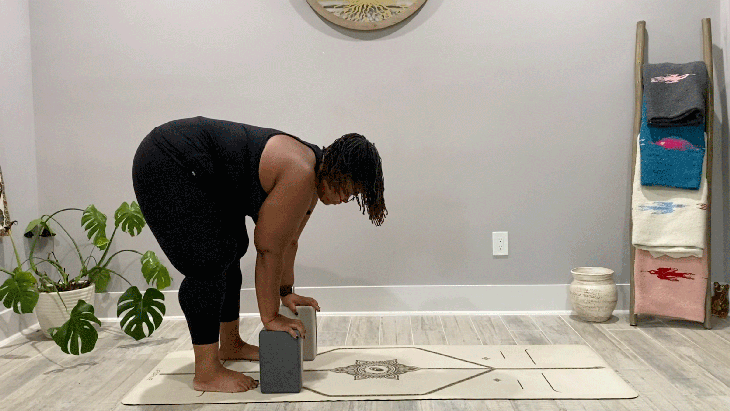
Turn the blocks onto the highest level. Press into them to come into Ardha Uttanasana (Standing Half Forward Bend), elongating your spine from your tailbone to the crown of your head. Fold forward again, allowing the blocks to remain under your hands as your elbows bend. Inhale and lift your arms to the sky in Urdhva Hastasana (Upward Salute), then, exhale and fall into Uttanasana, forward fold. Continue to explore Uttanasana, Ardha Uttanasana, and Urdhva Hastasana in this half Sun Salutation for 3 times.
After your last repetition, walk your hands and blocks back to Downward-Facing Dog. Enjoy a long extension across your upper back.
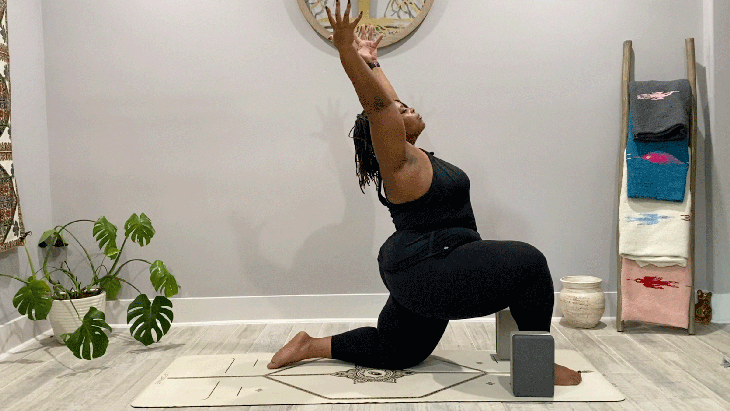
Anjaneyasana (Low Lunge) to Ardha Hanumanasana (Half Splits)
From Down Dog, step your right foot forward and lower your left knee for Low Lunge on the right side. Welcoming support from your blocks, draw your hips forward and notice the sensation in the left hip flexors at the front of the hip. Begin your slow flow here by inhaling and lifting your arms toward the ceiling.
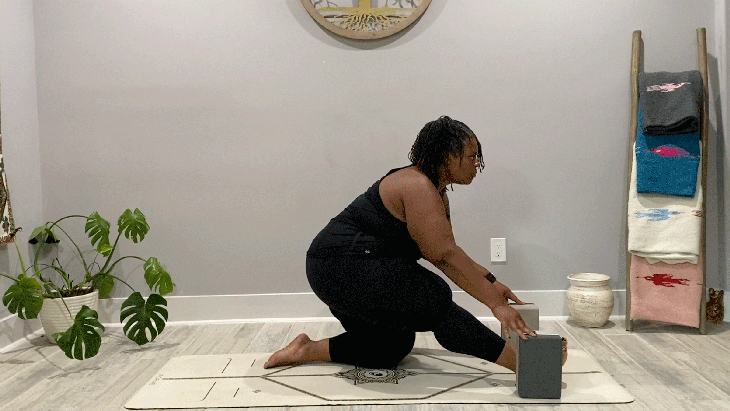
Then exhale and bring your hands to blocks as you shift your hips back and extend your right leg straight in front of you for Half Splits. Inhale, bend your front knee and draw your hips forward to Low Lunge, and then exhale and come into Half Splits.
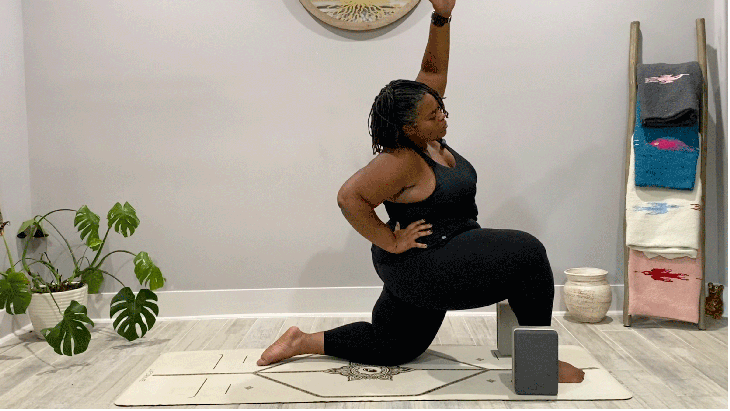
From Low Lunge, bring both your hands to your sacrum as you shift your hips forward. Leave your right hand at the sacrum as you inhale and reach your left hand up and over toward the right for a side bend. Stay for the exhale. Inhale and release to center.
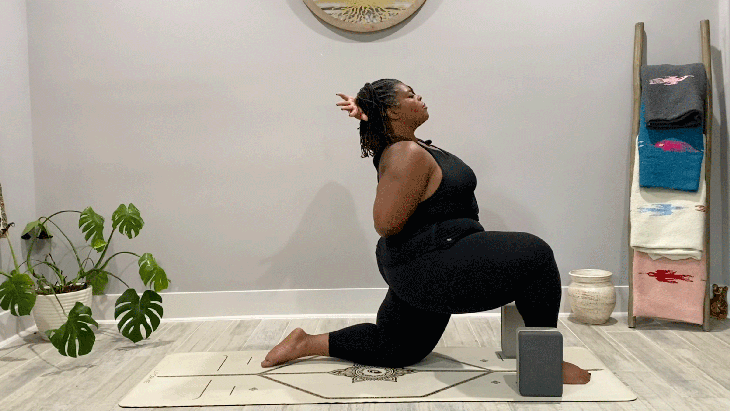
Bring your left forearm behind your head and wrap your right arm behind your back. Lean back into your left arm for an archer variation.
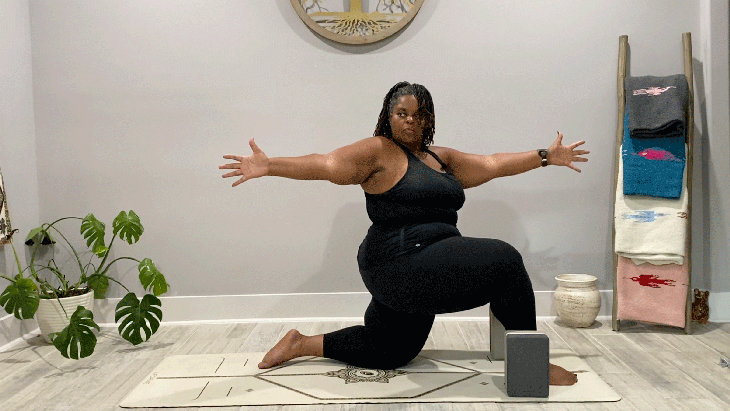
Release your left arm forward as you draw your right arm back for an open twist. Stay for an exhale. Reach both arms to the sky, then release them to the mat.
From all fours, with or without your blocks, move through 3 rounds of Cat-Cow and then come back to Downward-Facing Dog. Repeat the slow flow on the left side, exploring dynamic Low Lunge to Half Splits, Low Lunge with side bend, with a wrap, and with an open twist.
Release to all fours. Move the blocks out of the way, then lower your whole body to the mat. Explore low Cobra dynamically again, engaging your lower body as you lift your head and heart away from the mat 3 times.
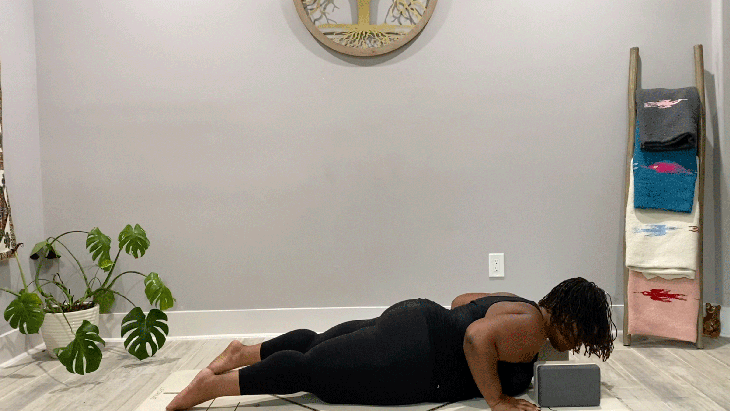
Salabhasana (Locust Pose)
From Cobra, lower your head and chest to the mat. Bring your hands next to your hips, palms down. Notice the connection between your hands and the ground. Engage everything from your toes to your torso as you lift your head and chest away from the mat. Engage from the hip flexors and pelvis, lift your legs away from the mat in Locust Pose. Notice the grounding of hands to the mat as you sense the upward movement of your upper and lower body. If there is any pain feedback from your lower back, try pressing your feet into the mat. Stay here for 3 breaths.
Release to Child's Pose.
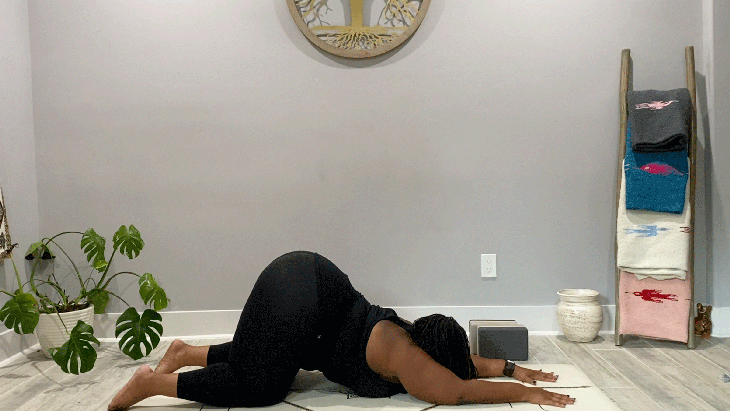
Anahatasana (Puppy Pose)
From Child's Pose, send your hips forward so that they are stacked over your knees. Extend your arms long to bring your chest and forehead, lips, or chin to the mat in Puppy Pose. Feel for the support of the ground underneath your chest, arms, and head. Stay for 3 breaths.
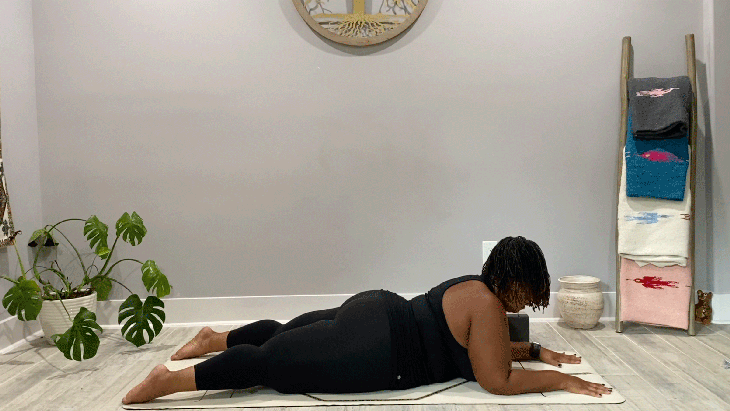
Supported Sphinx Pose
From Puppy, release to the mat. Drag your upper body forward to rest your abdomen on the mat. Prop your elbows underneath your shoulders for supported Sphinx Pose. Notice the connection between the front of your body and the floor while engaging along your back body. Stay here for 3 breaths and then release yourself to the mat.
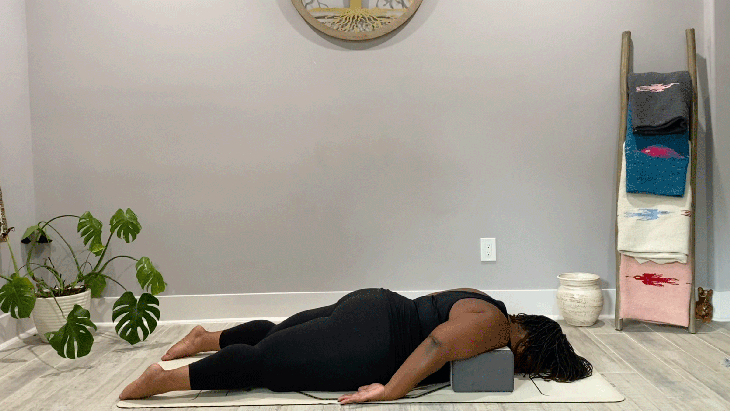
Salamba Salabhasana (Restorative Locust Pose)
Turn the blocks on the medium level and bring them alongside your chest and underneath the fronts of your shoulder and upper arms. Turn your palms toward your body, and then rotate them towards the ceiling. Rest your head onto the mat or a folded blanket and let the blocks support your upper arms in this gentle locust variation. Stay for 5 breaths (or longer). Release the whole body to the floor.
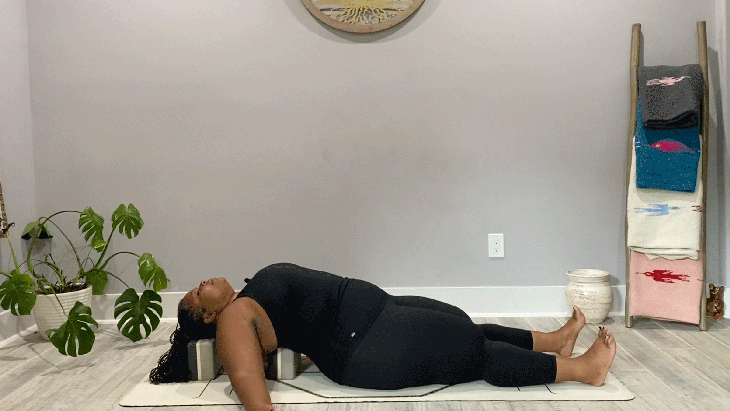
Salamba Matsyasana (Supported Fish Pose)
Make your way back to upright and bring blocks on their medium height where they will support your head and your middle back. Come to lying back onto the blocks while leaving your knees bent. Notice the opening around the upper body as your lower body remains connected to the floor.
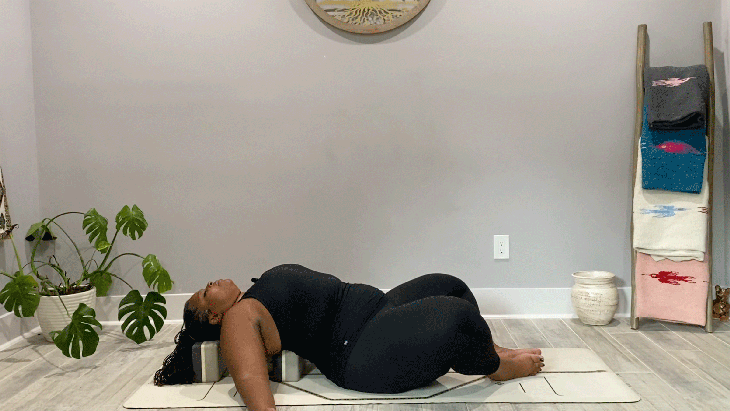
Supta Baddha Konasana (Reclining Bound Angle)
Leaving the blocks where they are, bring the soles of your feet together and let your knees bow out to the sides for Reclining Bound Angle. Begin welcoming in ease and softness as you remain here for 5 breaths (or longer).
If you like, you can straighten your legs. If this brings discomfort to your lower back, come back to bent knees.
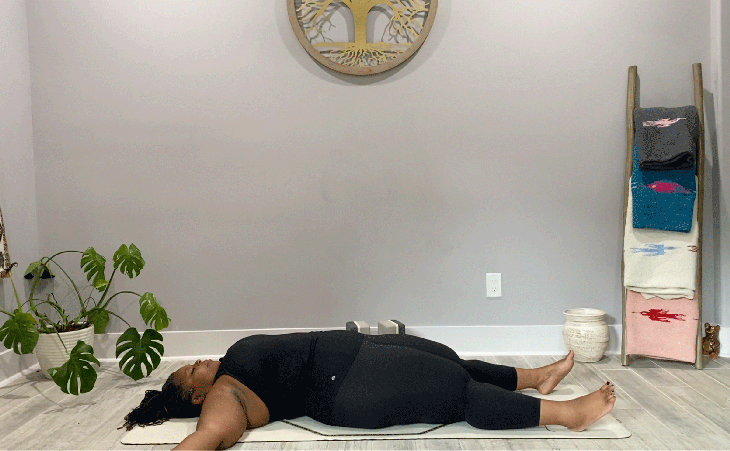
Savasana (Corpse Pose)
From Restorative Fish, remove the blocks from under your body. Release your upper body to the mat as you extend both legs long for Savasana. Enjoy rest for as long as time allows. Hopefully you feel more grounded, peaceful, and calm--qualities that you can then take into the rest of your day.
About our contributor
Tamika Caston-Miller, E-RYT 500, is the director of Ashe Yoga, where she curates yoga experiences and trainings in service of collective healing and community repair. Having begun her yoga journey in 2001 with a home practice, she now holds advanced certifications and training in Trauma-Informed Yoga, Somatics, Yin Yoga, Restorative Yoga, and Yoga Nidra. Tamika's journey has been informed by chronic pain and injuries, social justice for QTBIPOC communities, the battle between shame and compassion and quest for ancestral healing, and the love for the practice and philosophy of yoga.
For exclusive access to all of our fitness, gear, adventure, and travel stories, plus discounts on trips, events, and gear, sign up for Outside+ today.

